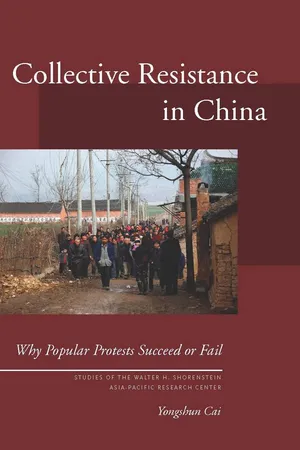
- 304 pages
- English
- ePUB (mobile friendly)
- Available on iOS & Android
About this book
Although academics have paid much attention to contentious politics in China and elsewhere, research on the outcomes of social protests, both direct and indirect, in non-democracies is still limited. In this new work, Yongshun Cai combines original fieldwork with secondary sources to examine how social protest has become a viable method of resistance in China and, more importantly, why some collective actions succeed while others fail.
Cai looks at the collective resistance of a range of social groups—peasants to workers to homeowners—and explores the outcomes of social protests in China by adopting an analytical framework that operationalizes the forcefulness of protestor action and the cost-benefit calculations of the government. He shows that a protesting group's ability to create and exploit the divide within the state, mobilize participants, or gain extra support directly affects the outcome of its collective action. Moreover, by exploring the government's response to social protests, the book addresses the resilience of the Chinese political system and its implications for social and political developments in China.
Frequently asked questions
- Essential is ideal for learners and professionals who enjoy exploring a wide range of subjects. Access the Essential Library with 800,000+ trusted titles and best-sellers across business, personal growth, and the humanities. Includes unlimited reading time and Standard Read Aloud voice.
- Complete: Perfect for advanced learners and researchers needing full, unrestricted access. Unlock 1.4M+ books across hundreds of subjects, including academic and specialized titles. The Complete Plan also includes advanced features like Premium Read Aloud and Research Assistant.
Please note we cannot support devices running on iOS 13 and Android 7 or earlier. Learn more about using the app.
Information
Notes
Chapter 1
Table of contents
- THE WALTER H. SHORENSTEIN ASIA-PACIFIC RESEARCH CENTER
- ALSO PUBLISHED IN THE SHORENSTEIN ASIA-PACIFIC RESEARCH CENTER SERIES
- Title Page
- Copyright Page
- Dedication
- Table of Contents
- Table of Figures
- List of Tables
- Acknowledgments
- ONE - Introduction
- TWO - Social Conflicts and Collective Resistance in China
- THREE - Obstacles to Successful Resistance in China
- FOUR - Issue Linkage and Effective Resistance
- FIVE - Social Networks and Effective Resistance
- SIX - The Power of Disruptive Collective Action
- SEVEN - The Limits of Disruptive Tactics: The Use of Violence
- EIGHT - Popular Resistance and Policy Adjustment
- NINE - Conclusion
- APPENDIXES - Data Collection
- Notes
- Bibliography
- Index